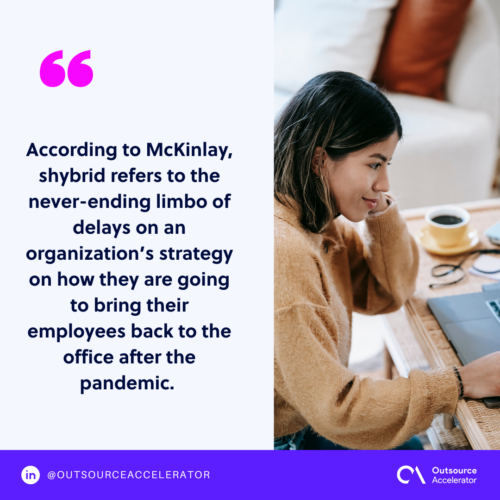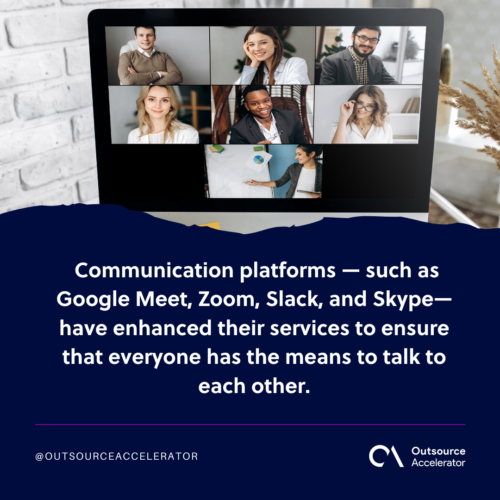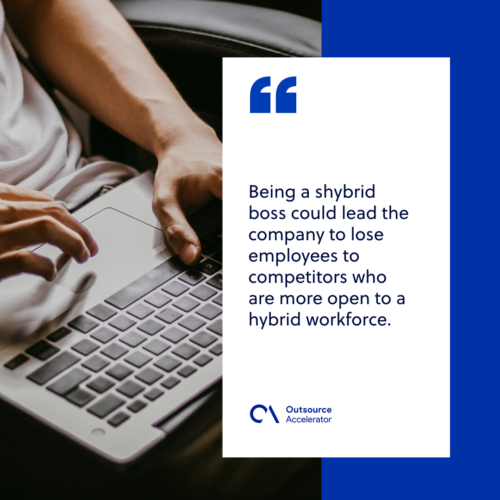How ‘shybrid’ working can negatively impact companies in the new normal

Employers cannot afford to be shybrid when it comes to their workplace models, especially in this Great Resignation era. Going back and forth on post-pandemic workplace strategies could adversely affect the organization.
Now that the vaccination rate is high and infection cases are going low, it is time for bosses to decide if they will go back to how things were before or adapt to the workplace changes brought on by the pandemic.
What is the meaning of ‘shybrid’?
Cimpress VP of communications and remote working Paul McKinlay originally coined the term “shybrid” during an interview with Bloomberg in December 2021.
According to McKinlay, shybrid refers to the never-ending limbo of delays on an organization’s strategy on how they are going to bring their employees back to the office after the pandemic.
This is often caused by employers who have failed to understand that they have “lost the right to demand in-person attendance” five days a week.
According to the 2022 Employee Insights on Hybrid Work Report by workplace analytics platform Density and market research firm YouGov, 59% of employees demand schedule flexibility in their workplaces. However, over 50% of companies do not offer hybrid working plans for their workers.
Delaying the release of a solid workplace strategy on how operations would continue can negatively impact employee productivity, happiness, and loyalty to the company.

What drives companies to stay shybrid?
Employers who still don’t want to let go of the idea of a traditional office environment are known as shybrid bosses. They are the ones pushing for things to go back to how it was pre-pandemic despite the obvious choice of hybrid working.
But why do some employers feel the need to stay traditional and continue being shybrid about their work models?
Productivity is the primary concern of most business owners. Several employers believe that since their employees are not under their “watchful eye” anymore, they would slack off on their tasks and responsibilities.
However, since the lockdown and quarantines started, most reports and research have proved this is not the case for most companies. A PwC report has shown that remote or hybrid working boosted productivity as most organizations performed thrice better for the past 12 months than the pre-pandemic times.
On the other hand, other bosses believe that a full-time office model creates a focused environment where employees can prioritize their work and talk to their colleagues in real time to share ideas.
Additionally, other managers are worried that employee engagement would decrease since workers can’t personally see each other every day. They believe that the lack of face-to-face interaction would also weaken the overall company culture.
However, communication platforms — such as Google Meet, Zoom, Slack, and Skype— have enhanced their services to ensure that everyone has the means to talk to each other.

Disadvantages of staying shybrid in a post-pandemic world
Working in the office five times a week is not as attractive as before. Staying at home for two years made each person reevaluate their lifestyle and prioritize what is best for their health and safety.
Staying shybrid is considered outdated by current standards. The following are the reasons why:
Most talents prefer flexibility
Instead of working eight to nine hours, five times a week in an office, most employees were compelled to work remotely to avoid the spread of the COVID-19 virus.
Once everyone adjusted to the change, what was once a challenging work model became the most sought-after by workers.
Fast forward to now, remote or hybrid working is widely viewed as a means for workers to have a healthier work-life balance. They get to spend less time commuting and more time doing other activities besides their responsibilities at work.
Work-life balance gets compromised
Going back to the office full-time after two years of staying at home can cause anxiety for several employees. After a long period of isolation, being out in crowds could stress most workers and make them worry about their health and safety.
Additionally, forcing people back on-site could lead to burnout. This could show up in three main ways: exhaustion, cynical detachment, and a reduced sense of self-worth.
Being shybrid creates chaos and confusion
Shybrid employers who cannot make a solid business strategy may give rise to confusion and apprehension among the staff.
The lack of proper workplace planning post-pandemic can signify that the employer does not care enough for the welfare of their employees. This, in turn, leads to them losing several talents.
A high employee turnover creates a disturbance in the company’s daily operations and, ultimately, a loss of revenue for the business.
Most companies are now promoting a hybrid model
The workplace culture has changed. Gone are the days when workers are more agreeable to employers’ demands.
The past stay-at-home regulations reshaped people’s lifestyles and allowed them to prioritize their needs. Due to this, many professionals are ready to quit their jobs if their company’s terms do not agree with their requests.
Being a shybrid boss could lead the company to lose employees to competitors who are more open to a hybrid workforce. Employers who fail to adapt to the demands of their workforce could experience failure sooner than they think.

Shybrid vs. hybrid: what would work best for your company?
Even though we have already enumerated the negative impacts of a shybrid workplace, the reality is not everyone’s the same. Some people find productivity and happiness while working at home, while others are more efficient at the office.
That is why the best thing that employers should do is ask for their employees’ opinions and consider their suggestions. Do a company-wide survey and take into account their answers.
Employers who listen and adapt to the changes in the workplace these past two years are much more likely to be successful in building their organizations back together post-pandemic.
Whether it be full-time office work, hybrid, or full-time remote, it is in the best interest of business owners to listen to whatever it is that their workers need.







 Independent
Independent




